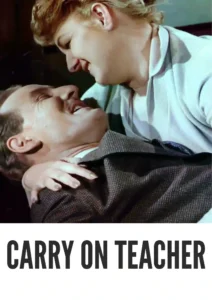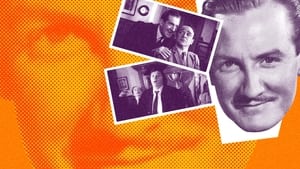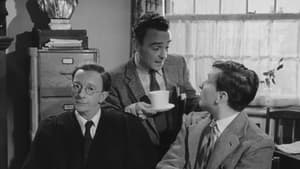Contact: info@alwanfilm.com
Video Sources 0 Views

Carry On Teacher 1959 Colorized
Synopsis
Review: Carry On Teacher 1959 Colorized – A Classic British Comedy That Still Teaches Us Lessons

Introduction
Released in 1959, Carry On Teacher is part of the beloved Carry On film series, known for its quintessentially British humor, slapstick comedy, and ensemble cast. Directed by Gerald Thomas and produced by Peter Rogers, Carry On Teacher offers a humorous and nostalgic look at school life, while also subtly poking fun at the British education system. While it’s one of the early black-and-white films in the series, its lively humor and entertaining characters have endured across generations.
In this article, we’ll delve into the charming world of Carry On Teacher, exploring the performances of its talented cast, examining the storyline, and discussing its role within the broader context of the Carry On franchise. Additionally, we’ll reflect on the debate around whether this film would benefit from colorization, given its place in British comedy history.
Check The Full Colorized Movies List
Check Our Colorized Movies Trailer Channel
Understanding Carry On Teacher 1959 Colorized: Director, Cast, and Genre
Carry On Teacher was helmed by director Gerald Thomas, who directed every film in the Carry On series, establishing a long-running collaboration with producer Peter Rogers. This film is one of the earlier installments in the franchise, which would eventually produce 31 films between 1958 and 1992. Like the others in the series, Carry On Teacher is built around an ensemble cast that features some of the most famous British comedic actors of the time.
The Cast
Sidney James, a regular in the Carry On films, plays William Wakefield, the headmaster of Maudlin Street School, who dreams of leaving for a new post at another school. Kenneth Connor stars as Gregory Adams, the timid and lovestruck science teacher, while Charles Hawtrey is Alistair Grigg, a quirky, neurotic music teacher. The cast also includes Joan Sims as Miss Allcock, the idealistic gym teacher, and Hattie Jacques as the strict but caring Deputy Headmistress, Grace Short.
The film exemplifies the genre of British slapstick comedy, rooted in farcical misunderstandings, witty repartee, and exaggerated character traits. At the same time, it incorporates gentle satire, mocking the sometimes rigid and outdated British education system while endearing the audience to its characters. Although the film was shot in black-and-white, the vivid personalities of the actors brought a colorful energy to the screen.
Exploring the World of Carry On Teacher 1959 Colorized: Plot and Characters
Carry On Teacher is set in the fictional Maudlin Street School, where the beloved headmaster William Wakefield is on the verge of leaving for a new post. However, his plans to leave are complicated by the arrival of two school inspectors, Miss Wheeler (Rosalind Knight) and Mr. Gregory (Leslie Phillips), who are assessing the school’s performance.
The twist comes when Wakefield’s students, loyal and fond of their headmaster, decide to sabotage the inspectors’ visit to prevent Wakefield from leaving. The resulting antics create a series of comic misunderstandings and slapstick moments, from exploding science experiments to chaotic gym classes. Meanwhile, Gregory Adams (Kenneth Connor) tries to impress Miss Wheeler, leading to more misadventures and romantic confusion.
The plot is simple but effective, driving much of the humor through the clash between the well-meaning teachers, mischievous students, and officious inspectors. At its heart, the film is about loyalty, the bonds between teachers and students, and the timeless, often hilarious miscommunication between authority figures and those under their watch.
Key Characters
- William Wakefield (Sidney James): The stalwart headmaster who is deeply loved by his students but seeks new opportunities, leading to the chaos that unfolds.
- Gregory Adams (Kenneth Connor): The shy, awkward science teacher who provides some of the film’s most humorous moments as he clumsily attempts to court Miss Wheeler.
- Alistair Grigg (Charles Hawtrey): The eccentric music teacher who finds himself at the center of various chaotic situations, embodying the over-the-top personalities that define the Carry On films.
- Grace Short (Hattie Jacques): The stern but caring Deputy Headmistress who tries to keep the school in order amid the mayhem.
- Miss Allcock (Joan Sims): The energetic gym teacher who brings a touch of romance and youthful exuberance to the story.
The Art of Film Colorization
Film colorization, the process of adding color to black-and-white films, has been both celebrated and criticized within the film industry. Proponents of colorization argue that it can breathe new life into classic films, making them more accessible to modern audiences who may find black-and-white films less engaging. On the other hand, purists believe that colorizing films can undermine the director’s original vision, altering the intended atmosphere, tone, and aesthetic.
In the case of Carry On Teacher, which relies heavily on its comedic performances and character-driven humor, the debate over colorization becomes intriguing. While colorization could potentially enhance the visual appeal of certain scenes—such as the chaotic classroom experiments or the energetic gym sessions—the film’s comedy and charm are not dependent on its visual presentation. The exaggerated expressions, slapstick timing, and witty dialogue of the cast carry the film, ensuring its timelessness regardless of whether it remains in black-and-white.
Early Colored Films: A Brief History
The advent of color in film marked a significant milestone in cinematic history. Early experiments with color began in the early 20th century, with films like The Toll of the Sea (1922) using two-tone Technicolor, and later films such as The Adventures of Robin Hood (1938) utilizing the more advanced three-strip Technicolor process. By the 1950s, color had become more commonplace in Hollywood, with films like The Wizard of Oz (1939) and Singin’ in the Rain (1952) establishing themselves as iconic examples of the medium’s potential.
In British cinema, however, black-and-white remained the standard for many productions, particularly in the comedy genre. Films like Carry On Teacher opted for black-and-white for budgetary reasons, but also because the medium complemented the simple, direct humor that characterized the Carry On films. The absence of color allowed the focus to remain squarely on the performances and the script, without the distraction of a more elaborate visual palette.
Carry On Teacher and the Question of Colorization
Given the recent trend of colorizing classic films, it is worth considering whether Carry On Teacher would benefit from such treatment. The film’s lighthearted tone and playful energy might lend themselves well to the bright, vivid hues that colorization can offer, bringing more visual dynamism to the chaotic school setting.
For example, scenes like the science lab explosion or the gym class mishaps could be visually enhanced through color, heightening the absurdity of the situations. Similarly, the contrast between the stern inspectors and the mischievous students could be exaggerated with colorful costumes and settings, adding another layer of humor.
However, there is also something to be said for preserving Carry On Teacher in its original black-and-white format. The monochrome aesthetic gives the film a certain nostalgic charm, grounding it in the era in which it was made. Additionally, much of the film’s humor comes from the dialogue and character interactions, elements that remain unaffected by whether the film is in color or not.
The Debate Over Film Colorization
As with many classic films, Carry On Teacher sparks the broader debate over the merits and drawbacks of colorizing black-and-white films. While some argue that colorization can make old films more accessible to contemporary audiences, others contend that it compromises the director’s original artistic intent. This debate is particularly relevant for films like Carry On Teacher, where the visual style is closely linked to the film’s comedic rhythm and timing.
Supporters of colorization often cite its ability to bring new life to older films, making them more appealing to younger viewers who may be less inclined to watch black-and-white films. Color can also highlight details in sets and costumes that may otherwise go unnoticed, adding another layer of visual engagement. In Carry On Teacher, for instance, colorization could potentially enhance the visual humor, particularly in scenes of classroom chaos.
On the other hand, purists argue that colorizing films can strip away the subtlety and atmosphere that black-and-white photography provides. In Carry On Teacher, the simplicity of the black-and-white aesthetic complements the straightforward, no-frills comedy. The focus is on the performances, with the monochrome palette helping to create a sense of timelessness that might be lost with color.
Influence and Legacy: Carry On Teacher 1959 Colorized’s Impact on British Comedy
As one of the earlier entries in the Carry On series, Carry On Teacher helped solidify the template for British comedy films in the years that followed. Its success contributed to the longevity of the Carry On franchise, which became synonymous with a particular brand of humor that mixed slapstick with innuendo and farcical situations.
The film’s influence can be seen in later British comedies that revolve around school life and education, from TV shows like Please Sir! in the 1960s to the modern Bad Education series starring Jack Whitehall. The Carry On films, including Carry On Teacher, became a cultural touchstone, shaping the comedic landscape of British cinema and television for decades.
Director’s Cinematic Legacy: Gerald Thomas and the Carry On Franchise
Gerald Thomas, the director of Carry On Teacher, left an indelible mark on British cinema through his work on the Carry On series. His collaboration with producer Peter Rogers spanned over three decades, producing films that became synonymous with British humor and low-budget filmmaking.
Thomas’s directorial style emphasized timing, character-driven comedy, and a consistent use of an ensemble cast. He maintained a fast-paced, lighthearted approach to filmmaking, which allowed the Carry On series to become an enduring success. His ability to work with recurring actors and bring out the best in them played a key role in the longevity of the series.
Themes Explored in Carry On Teacher 1959 Colorized
Though Carry On Teacher is first and foremost a comedy, it also explores themes of authority, rebellion, and the relationship between teachers and students. The film reflects a certain nostalgia for the traditional British school system, even as it pokes fun at its more rigid and outdated elements.
Loyalty is another theme that resonates throughout the film. The students’ dedication to their headmaster, and their willingness to go to great lengths to keep him at the school, demonstrates the close bonds that can form in educational settings. The film’s portrayal of these relationships, though exaggerated for comic effect, carries an underlying message about the importance of mutual respect and understanding between teachers and students.
Reception and Controversy Surrounding Carry On Teacher 1959 Colorized
Upon its release, Carry On Teacher was well-received by both audiences and critics. The film’s lighthearted humor and endearing characters made it a hit with viewers, while its playful critique of the education system resonated with many. The Carry On films, though sometimes criticized for their bawdy humor, were beloved for their ability to offer escapism and entertainment during a time when British society was undergoing significant changes.
However, as with many films in the Carry On series, Carry On Teacher was not without its detractors. Some critics viewed the film’s humor as too broad or simplistic, while others felt that the series was beginning to repeat itself. Nonetheless, the film has endured as a favorite among fans of British comedy, and its charm remains intact more than six decades after its release.
Where to Watch Carry On Teacher 1959 Colorized Online
For those eager to revisit or discover Carry On Teacher, the film is widely available on various streaming platforms. It can be found on services like Amazon Prime Video, Apple TV, and BritBox, a streaming platform dedicated to British television and films. The film is also available for purchase on DVD or Blu-ray, often as part of Carry On box sets.
FAQs About Carry On Teacher 1959 Colorized
Q: Is Carry On Teacher suitable for all ages?
A: Yes, Carry On Teacher is a family-friendly film. While some of the Carry On films include risqué humor, Carry On Teacher is relatively mild in comparison and suitable for viewers of all ages.
Q: How does Carry On Teacher fit into the larger Carry On series?
A: Carry On Teacher is the third film in the Carry On series. It stands out as one of the more gentle and character-driven entries, focusing on school life and the relationships between teachers and students.
Q: Was Carry On Teacher filmed in color or black-and-white?
A: Carry On Teacher was filmed in black-and-white. While colorization has been considered for some older films, there has been no official colorized version of Carry On Teacher to date.
Conclusion
In conclusion, Carry On Teacher (1959) remains a delightful gem in British cinema, showcasing the best of the Carry On series with its charming humor, memorable performances, and nostalgic setting. While the debate over whether to colorize classic films continues, there is no doubt that Carry On Teacher remains timeless, regardless of whether it’s viewed in black-and-white or color. With its endearing characters and comic mishaps, the film still holds lessons for today’s audiences about the joys and chaos of school life, and the enduring bonds between teachers and students.
Whether you’re a die-hard Carry On fan or a newcomer to British comedy, Carry On Teacher is a must-watch that continues to entertain audiences more than six decades after its release.














